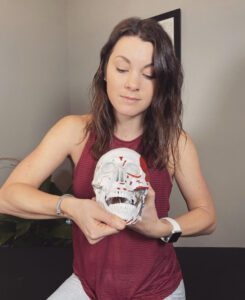What is TMJ/TMD?
Your temporomandibular joint (TMJ) connects your mandible or lower jaw to your temporal bone in your skull. TMJ is the anatomical term for this joint, whereas TMD stands for temporomandibular joint dysfunction. TMD is the term used to describe pain, abnormal movement, or other dysfunction of the TMJ.
Common Symptoms
There’s a wide array of symptoms that come with TMD including:
- Jaw pain
- Sore teeth
- Clicking/popping sounds
- Muscular soreness/fatigue in jaw or face-
- Ear fullness/ringing in the ears
- Difficulty chewing
- Headaches
- Neck discomfort
- Dizziness
- Decreased jaw range of motion
- Bite feels “off”
Many of these symptoms can be resolved with physical therapy treatment!
Why Physical Therapy?
Many are surprised to hear that physical therapists treat TMJ issues. But yes! We very much do, and it’s an established and growing specialty in the world of PT. We love to collaborate with many health care professionals including dentists, orthodontists and oral surgeons for optimal outcomes and to increase patient adherence to the treatment plan.

What makes seeing a PT different?
- Experts of anatomy and the musculoskeletal system- especially analyzing muscular imbalances and/compensations
- Very hands on- we get a feel for the muscles/joints of the TMJ, head, neck, back, shoulders
- Treatment takes a full body, comprehensive approach discussing all factors that could be contributing to your symptoms (ergonomics, stress levels, sleep hygiene, parafunctional habits, dental history)
- Implement re-training, stretching, and strengthening techniques to make changes LAST
- Loads of patient education so you feel EMPOWERED by understanding and ultimately become self-sufficient or we help guide you toward the best step for continued care
- You typically see us at least weekly, at least at first, so you have a regular resource/someone supervising your care and someone collaborating with your other providers
- Dry needling!
What to except in a TMD
Physical Therapy treatment plan
- After a thorough evaluation determining the patient is an appropriate candidate for PT intervention, my treatments often include:
- Manual therapy: this includes soft tissue work, joint mobilizations, muscle energy techniques and manual stretching for any involved structures of the head/neck/face as well as the mid back
- Dry needling: common muscles for this population include masseter, temporalis, SCM, trapezius, lateral pterygoid, levator scap, suboccipitals; I use a combination of pistoning and hand held e-stim on the needles
- Jaw neuro re-education/exercise: disc recapturing exercises with tubing, tongue movements, TMJ isometrics and other stretching/strengthening techniques to improve jaw mechanics
- Postural neuro re-education/exercise: specific movements from the trunk up to improve structure/stability that supports improved jaw mechanics
- Patient education: constant assessment of progress while providing education so the patient understands and can implement home exercises to increase carry over!
- Communication with other healthcare team members to note progress and continue to evaluate best course of care for optimal outcomes. Overall goal is always increasing function and improving quality of life for the patient.
The big takeaway is that there are often postural or musculoskeletal factors that are either the source or contributing to your TMD symptoms.
In physical therapy, we take the time to address these issues with manual therapy and appropriate exercises to retrain the body for lasting change or increase ability to comply with other measures such as a splint. We take a comprehensive approach to treatment understanding TMD is a multifactorial diagnosis and areas such as positioning, sleep and stress are important aspects of understanding the full picture.
Physical therapy is a very valuable step in the process of healing if not the answer to significant symptom relief for a wide range of TMD-related diagnoses.
Want to resolve your jaw pain and headaches today? Book here now!
About the author:

Dr. Samantha Dove is originally from San Antonio, Texas and has recently moved to Cincinnati from Atlanta, GA with her husband Sam and their dog Koda.
She was a springboard and platform diver for the University of Texas at Austin and has been a Doctor of Physical Therapy for over 5 years. Dr. Dove treats all orthopedic conditions with special interest in the spine, chronic pain, vestibular, and TMJ/TMD populations. She has her Manual Therapy Certification through the University of St. Augustine (USA) and has extensive dry needling training with KinetaCore.
Dr. Dove highly values continuing education in a variety of physical therapy topics but has taken special interest in the CranioFacial courses through USA to advance her TMD treatment skills. Health and wellness are a natural interest of hers in her personal life including participating in activities such as yoga, running, gardening, reading, cooking, family walks at Eden Park and all things self care! She is very excited to explore Cincinnati and to be joining the team at Anchor Wellness Center!


